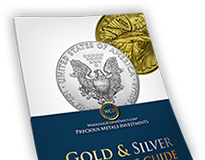- Gold $0.00 $0.00
- Silver $0.00 $0.00
- Platinum $0.00 $0.00
- Palladium $0.00 $0.00
Pricing:
| QUANTITY | E-CHECK/WIRE | CREDIT CARD |
|---|---|---|
| Any | $4,776.47 | $4,975.65 |

Get Our Free
Gold & Silver
Investor's
Guide
Description:
For the first few decades of the United States' existence as an independent country, the biggest authorized denomination of U.S. coin was $10. There were gold coins that had this face value and were each called an eagle; however, new denominations were later considered for gold coinage. A good reason for the United States Mint to consider these was how much more bullion was being sent to the east as a result of the California Gold Rush. This revolution started in 1848, with the discovery of gold at the sawmill Sutter's Mill in the Coloma area of California.
One of the fresh denominations to be introduced was the double eagle; this name derived from its $20 face value, double that of the $10 eagle. The first ever double eagle was designed by James B. Longacre, who served as the U.S. Mint's fourth Chief Engraver from 1844 right up to his 1869 death. The coin had an immediately positive reception, with banks and merchants putting it to trade purposes. Nonetheless, its design, which includes a picture of Liberty as a young woman wearing a coronet spelling "LIBERTY," has provoked mixed responses since the coin was publicly revealed.
This design was dismissed as routine by art academic Cornelius Vermeule, though he did commend particular features of heraldic imagery on the eagle-picturing reverse. He hinted that this side's design would not look unsuitable on the front of a patriotic brochure. Soon after the double eagle's introduction, one newspaper branded the eagle "imperfectly formed." Another contemporary outlet, The Journal of Commerce based in New York, advocated the bird's replacement with a more proud-looking eagle. However, the coin's same design has garnered considerable popularity with collectors in the 21st century.
There are three major versions of this design. The earliest, Type I, was struck year-after-year from 1850 until 1866. In reaction to fresh legislation, Longacre added "IN GOD WE TRUST" to the 1.342-inch-diameter double eagle for the Type II design produced from 1866. Its annual production persisted until 1876, but alterations by William Barber resulted in the Type III design from 1877. Barber was Chief Engraver that year and, when the Liberty double eagle eventually left production in 1907, it was still Barber's son, Charles E. Barber, who was in that position. Barber played a notable part in the development of this double eagle's successor, the Saint-Gaudens double eagle.
It was long the situation that many dates rarely appeared on Type I coins. However, recoveries of significant numbers of gold coins from shipwrecks have made particular issues more common, including 1857, 1864, and 1865 San Francisco Mint discs and 1865 Philadelphia Mint iterations. It is however still the case that plenty of Liberty double eagle issues are scarce, posing challenges that could easily daunt many collectors. You could circumvent such difficulties by collecting double eagles for their designs rather than their issue dates.
Picking up various Liberty double eagles can be closer to your reach when your initial attention is focused on "common date" coins, which sufficient availability would allow you to buy via this page.
Features of the Common Date $20 Liberty Gold Double Eagle MS62:
- Possibility of below-eagle mint mark
- Eye appeal that is acceptable on the whole
- 0.96750 troy oz of gold paired with 10% copper.
Orders placed for products that are not a specific year will be fulfilled with coins of any date, based on availability. Orders of multiple coins may be filled with the same year or a variety of years.
Specifications:
| Product Type | Coin |
|---|---|
| Coin Series | Pre-33 Gold |
| Purity | 90% |
| Mint/Refinery | U.S. Mint |
| Metal Type | Gold |
| Face Value | $20 |
| Grade | MS62 |
| Coin Type | Certified |
| Modern or Historical | Pre-33 |
| Grade Service | NGC |
| Year | Varies |
| Metal Weight | 0.9675 troy oz |







